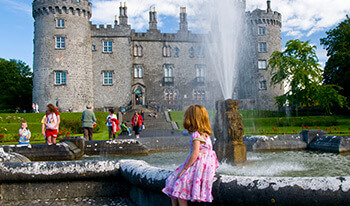Glendalough Monastic Site
Located in the Wicklow mountains, is the early Christian monastic settlement of Glendalough also known as the Glen of the Two Lakes. It is one of the most breathtaking places to visit in Ireland.
Glendalough is a glacial valley renowned for its early medieval monastic settlement founded in the 6th century by St Kevin who was a hermit priest. His fame as a holy man spread and he attracted numerous followers. It flourished for six centuries after his death and the irish annals contain references to the deaths of abbots and raids on the settlement.
At the Synod of Rath Breasail in 1111, Glendalough was designated as one of the two dioceses of North Leinster. St. Laurence O'Toole, born in 1128, became Abbot of Glendalough and was well known for his sanctity and hospitality. Even after his appointment as Archbishop of Dublin in 1162, he returned occasionally to Glendalough, to the solitude of St. Kevin's Bed. He died in Eu, in Normandy in 1180.
In 1214, the dioceses of Glendalough and Dublin were united and from that time onwards, the cultural and ecclesiastical status of Glendalough diminished. The destruction of the settlement by English forces in 1398 left it a ruin but it continued as a church of local importance and a place of pilgrimage. Descriptions of Glendalough from the 18th and 19th centuries include references to occasions of "riotous assembly" on the feast of St. Kevin on 3rd June.
The present remains in Glendalough tell only a small part of its story. The monastery in its heyday included workshops, areas for manuscript writing and copying, guest houses, an infirmary, farm buildings and dwellings for both the monks and a large lay population. The buildings which survive probably date from between the 10th and 12th centuries.
Among the ruins that remain today include:
- An impressive Round Tower standing 30m high
- St Mary’s Church
- A 12th century Romanesque style Priest’s House
- A large granite cross (6th or 7th century)
- A Cathedral, the largest church on the site which contains a chancel, sacristy and a nave. (11th or 12th century)
- St. Kevins Church also known as St kevin’s Kitchen, which is a barrel-vaulted oratory with a pitched roof and a round tower belfry (12th century)
Tours featuring this attraction
Peace of Mind Guarantee
Your trip, worry free!Our Ireland based team is on call throughout your vacation!


